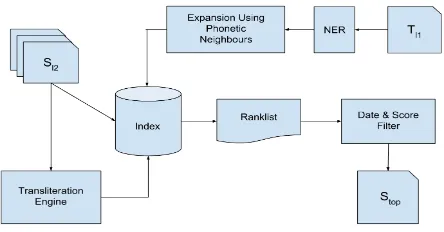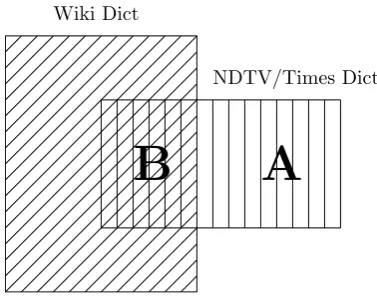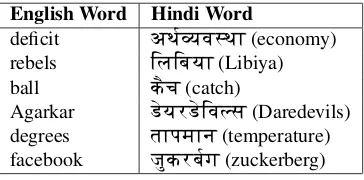Enrichment of Bilingual Dictionary through News Stream Data
Ajay Dubey
∗, Parth Gupta
†, Vasudeva Varma
∗, Paolo Rosso
† ∗Search and Information Extraction LabInternational Institute of Information Technology Hyderabad, India
ajay.dubey@research.iiit.ac.in,vv@iiit.ac.in
†Natural Language Engineering Lab
PRHLT Research Center
Universitat Polit`ecnica de Val`encia, Spain
http://www.dsic.upv.es/grupos/nle {pgupta,prosso}@dsic.upv.es
Abstract
Bilingual dictionaries are the key component of the cross-lingual similarity estimation methods. Usually such dictionary generation is accomplished by manual or automatic means. Automatic generation approaches include to exploit parallel or comparable data to derive dictionary entries. Such approaches require large amount of bilingual data in order to produce good quality dictionary. Many time the language pair does not have large bilingual comparable corpora and in such cases the best automatic dictionary is upper bounded by the quality and coverage of such corpora. In this work we propose a method which exploits continuous quasi-comparable corpora to derive term level associations for enrichment of such limited dictionary. Though we propose our experiments for English and Hindi, our approach can be easily extendable to other languages. We evaluated dictionary by manually computing the precision. In experiments we show our approach is able to derive interesting term level associations across languages.
Keywords:cross-lingual, statistical dictionary generation, news stream
1.
Introduction
Cross-lingual term associations are very important for many inter-lingual applications. Bilingual dictionary is one such important resource where entries are word transla-tions. Statistically generating a bilingual dictionary is more difficult for an under-resourced language pair for which not large amount of parallel and/or comparable data is available. Although there are few parallel corpora on the web, there is much comparable data and even more quasi-comparable. Documents in quasi-comparable collections are not topically aligned. Although our approach is generic, in this work we focus on the task of bilingual dictionary generation for an under-resourced language pair English-Hindi (en-hi).
One of the largest cross-lingual resource for en-hi pair is Wikipedia. Aligned Wikipedia for en-hi contains 30k doc-uments. Although it is a large and highly structured re-source, it is growing at a very slow rate for under-resourced languages like Hindi compared to other languages like En-glish, Spanish, Chinese, Arabic etc.
Hindi is very under-represented on the web because of many technical and socio-cultural reasons (Ahmed et al., 2011). The only few sources of Hindi text on the web are news articles, personal blogs, social media and song lyrics. News stream data look very attractive because of its nat-ural language content and continuous generation in large amount across languages.
In this study we try to identify the news stories across lan-guages which are reported on the same news event and then extract cross-lingual word translations from such articles. Recently Barker and Gaizauskas (2012) have defined the taxonomy of news articles. According to the same
taxon-omy, we try to link news stories across languages with same focal event which might serve as a comparable corpora. Af-terwards, we apply dictionary generation algorithm to ex-tract bilingual dictionary. Our method is completely auto-matic and does not rely on any labelled information. We compare the dictionary generated by our method to the dic-tionary generated from Wikipedia. Naturally the dicdic-tionary generated from the Wikipedia is of high quality because of the highly structured information like title, section, sub-section etc. and inter-lingual links. We demonstrate that our method is able to find some associations which are not present in the Wikipedia. We also present a thorough anal-ysis of the generated dictionary.
In Section 2. we discuss the related work. We present our method in detail in Section 3.. Section 3 contains the results and analysis of our method. Finally in Section 5. we outline the main findings of the study.
2.
Related Work
There have been approaches to extract bilingual content out of quasi-comparable corpus. Most of the attempts are to-wards extracting parallel sentences or fragments out of non-parallel or quasi-comparable corpora (Fung and Cheung, 2004; Munteanu and Marcu, 2005; Munteanu and Marcu, 2006; Chu et al., 2013). All of these approaches rely on a strong seed translation lexicon and take some type of boot-strapping approach.
later cross-lingual term associations were used for the task of CLIR. Braschler and Sch¨auble (1998) also devised sim-ilar approach where they linked English news stories to German stories using meta descriptors and common proper nouns1They replaced the monolingual ranklist by the
cor-responding cross-lingual aligned article and then expanded the query through pseudo-relevance feedback techniques. These approaches are tested on specific task of CLIR where finding the word translations is not a constraint. In a similar approach to find word translations, Rapp (1999) carried ex-periments over English-German news stories with a small base German to English base lexicon and tested the accu-racy over 100 test words.
The dimensionality reduction techniques are also used to align cross-lingual documents. The most celebrated ap-proach is cross-language latent semantic indexing (CL-LSI) (Dumais et al., 1997). CL-LSI falls into the category of linear dimensionality reduction techniques which by us-ing parallel documents tries to reduce the dimensionality to topkprincipal components to represent the data in reduced abstract space. The translingual documents are compared to each other in the low-dimensional abstract space and the closest pairs are considered topically aligned. There has been an extension to CL-LSI called oriented principal com-ponent analysis (OPCA) which formulates the problem as generalised eigenproblem (Platt et al., 2010). These ap-proaches require parallel training collection for training. Recently the cross-language !ndian news story search (CL!NSS) track of FIRE has created a benchmark collec-tion and evaluacollec-tion framework for news stories linking task for resource poor language pairs like English-Hindi (en-hi) and English-Gujarati (en-gu) (Gupta et al., 2012). The approaches based on machine translation techniques have shown to perform well but they are considerably slow espe-cially when dealing with document collection of a few hun-dred thousand (Palkovskii, 2012; Gupta et al., 2012; Gupta et al., 2013, and references therein).
3.
Approach
For an under-resourced language pair like en-hi, the exist-ing attempts are not reliable as any strong parallel seed cor-pus is unavailable. Hence, it is important to devise a tech-nique which can derive cross-language term translations from quasi-comparable corpora. Such approaches should have two inherent characteristics: i) they should be fast enough to digest large amount of data quickly (IR like ap-proach), andii)they should not depend on high-level cross-lingual resources.
The final aim of our approach is to generate a bilin-gual dictionary automatically from a cross-linbilin-gual quasi-comparable corpus. There are two natural component of our approach
• News stories linking
• Inflating the dictionary entries
1As the English and German are written using Roman script,
simple normalisation steps and diacritics handling would take care of proper nouns matching. If the languages are written using dif-ferent scripts, it would require to induce transliteration schemes.
The former step links the target article tiTl1to the source
article sj Sl2, where T and S are the collection of target
and source news stories respectively in language l1and l2.
The latter step takes the most frequent pairs of co-occurring words from the source and target news stories considered as comparable documents.
3.1.
News Story Linking
[image:2.595.312.534.277.393.2]In order to compare the documents in the collection across languages we first index each article in the source collec-tion. The source articles are composed of title and content field. We index both fields separately and the unit of index is term and its transliteration using a naive rule based pho-netic transliteration engine. The news story linking compo-nent is depicted in Figure 1.
Figure 1: System architecture for news story linking.
Eachtjis queried on the index to find most relevant source
documentsi. The query is composed of named entities in
thetj and its transliteration equivalents. We find phonetic
neighbours of the query term in transliterated vocabulary space using Editex algorithm (Zobel and Dart, 1996). Such expanded query is used to retrieve source documents from the index with the goal to find the same news story in the language. A date and score based filtering is applied on the ranklist to remove news story which were published beyond a distance of±n days from ti and have similarity
score less than a threshold. This is inspired by the findings reported in (Barker and Gaizauskas, 2012) that news stories with same news event and focal event tend to be published in a close vicinity of the target news story dates and are expected to contain parallel or comparable content.
3.2.
Dictionary Generation
4.
Evaluation and Analysis
We evaluate our approach on both the subtasks. The evalu-ation of news story linking is carried on a benchmark col-lection of news story linking task. Once the satisfactory performance is achieved and parameters are tuned, we run the dictionary generation module.
4.1.
News Story Linking
For the news story linking subtask evaluation, we use pub-licly available CL!NSS 2012 dataset2. The corpus
con-tains around 50k Hindi news stories in the source collec-tion which is the 2010 crawl of Navbharat Times3. The
tar-get collection contains few selected English articles from Times of India4. The task is to link each target news story
to source news stories which have the same focal event and news event. More details about the task and the dataset can be found in (Gupta et al., 2012).
Position Best System Our Method
1 0.3229 0.3659
2 0.3177 0.378
3 0.3106 0.3581
4 0.3151 0.3854
5 0.3259 0.3879
10 0.338 0.3978
20 0.36 0.4162
[image:3.595.315.529.68.155.2]50 0.3741 0.4689
[image:3.595.84.257.286.394.2]Table 1: Performance evaluation of the News story linking module.
[image:3.595.84.256.287.395.2]Table 1 presents the performance evaluation of the news story linking module and its comparison with the best sys-tem of the last year of the shared task. We also plot the dis-tance of the relevant documents from its target news story in terms of publication date which is depicted in Fig 2. It should be noted that most of the relevant news stories are published within the date window of 10 days.
Figure 2: Analysis of relevance judgment data of CL!NSS data.
Once we tune the parameters of our approach on the bench-mark collection, we crawl NDTV - a news agency archives5
2
http://www.dsic.upv.es/˜pgupta/clinss/ 2012/
3
http://navbharattimes.indiatimes.com/ 4
http://timesofindia.indiatimes.com/ 5http://archives.ndtv.com/articles/
Year English Hindi Pairs
2008 98198 61248 24268
2009 125527 55509 26333 2010 148081 72625 59815 2011 221801 117157 95721 2012 227070 116020 132478 2011-12 (NDTV) 91838 27560 10160
Table 2: Statistics of the news stream data for years 2008-12 for Times of India and Navbharat Times and 2011-2008-12 for NDTV.
for years 2011 and 2012. We also crawled Times of India and Navbharat Times for English and Hindi news stories re-spectively for 5 years (2008-2012) referred as Times. The statistics of the crawl is depicted in Table 2. We run our algorithm on the NDTV and Times datasets separately to find the news story links among them. The number of links found are also listed in Table 2.
4.2.
Dictionary generation
We ran the dictionary generation algorithm on the discov-ered news story links across the languages. The dictionar-ies generated with our method contains around 2550 map-pings for NDTV and around 4000 mapmap-pings with overall accuracy of 45%. The dictionaries are manually evaluated. Figure 3 presents the accuracy diagram for the dictionar-ies from the top position to the last one. It should also be noted that the on top positions, the method is able to find word translations with high quality. The dictionary gener-ated with Times data shows an improvement in qualitye.g.
there are∼2000 mappings over the accuracy threshold of 0.6 while with NDTV there are∼1000.
We compare our dictionary with that generated from Wikipedia as described in (Dubey and Varma, 2013). We first check which terms are present in both the dictionary and their accuracy. We also check the dictionary entries found by our method which are not present in the Wikipedia dictionary. Venn diagram in Figure 4 shows two sets of dic-tionaries and Table 3 presents their statistics.
B
A
Wiki Dict
NDTV/Times Dict
Figure 4: Venn diagram of dictionary coverage for the erated dictionaries (NDTV/Times) and the dictionary gen-erated using Wikipedia.
[image:3.595.51.293.539.656.2] [image:3.595.326.515.561.709.2](a) (b)
Figure 3: Accuracy analysis of dictionary entries: (a) NDTV and (b) Times
Partition Size Accuracy
A (NDTV) 709 36%
A (Times) 2231 31%
B (NDTV) 1841 47%
B (Times) 1662 67%
[image:4.595.332.514.297.387.2]B (Wiki) 1841 72%
Table 3: Accuracy and coverage statistics of the generated dictionaries and comparison with the dictionary generated using Wikipedia based on Figure 4.
As can be noticed from the Table 3, dictionary generated by Wikipedia is of high quality but it should also be noted that Wikipedia is a comparable corpus where articles are topically aligned and the articles are highly structurede.g.
titles and sections. On the contrary, our algorithm is able to find word translations from a completely unlabeled data from the web which is growing continuously and with a much higher rate than Wikipedia. It can also be observed that the quality of the dictionary increases with incorpora-tion of more datae.g. the dictionary with Times corpus is of higher quality than that of NDTV corpus.
Many of the negative entries in the dictionary generated by our algorithm are very closely topically related. Ta-ble 3 presents some of such negative results from the gen-erated dictionary. For example, term “deficit” is associ-ated to (Hindi equivalent of) “economy”, “rebels” with “Li-biya”, “ball” with “catch” (in context of cricket), “Agarkar” with “Daredevils” where former is the cricketer of latter team. It also makes our dictionary interesting for some cross-lingual applications like cross-language information retrieval (CLIR) and cross-lingual text categorisation. The generated dictionaries and the code are made publicly avail-able6.
6http://www.dsic.upv.es/grupos/nle/
quasi-dict/
English Word Hindi Word
deficit aT&yv-TA(economy) rebels ElEbyA(Libiya) ball k{c(catch)
Agarkar XyrXEvSs(Daredevils) degrees tApmAn(temperature) facebook яkrbg(zuckerberg)
Table 4: Incorrect but closely related entries in the gener-ated dictionaries.
5.
Remarks
[image:4.595.101.240.298.375.2]Acknowledgment
This work is carried out in the framework of the WIQ-EI IRSES project (Grant No. 269180) within the FP 7 Marie Curie. The work of the second and fourth authors is also supported by the DIANA APPLICATIONS Finding Hid-den Knowledge in Texts: Applications (TIN2012-38603-C02-01) project and the VLC/CAMPUS Microcluster on Multimodal Interaction in Intelligent Systems.
6.
References
Ahmed, U. Z., Bali, K., Choudhury, M., and VB, S. (2011). Challenges in designing input method editors for indian lan-guages: The role of word-origin and context. In Pro-ceedings of the WTIM ’11, pages 1–9, Chiang Mai, Thai-land, November. Asian Federation of Natural Language Processing.
Barker, E. and Gaizauskas, R. J. (2012). Assessing the comparability of news texts. In Calzolari, N., Choukri, K., Declerck, T., Dogan, M. U., Maegaard, B., Mari-ani, J., Odijk, J., and Piperidis, S., editors,LREC, pages 3996–4003. European Language Resources Association (ELRA).
Braschler, M. and Sch¨auble, P. (1998). Multilingual in-formation retrieval based on document alignment tech-niques. InECDL, pages 183–197.
Chu, C., Nakazawa, T., and Kurohashi, S. (2013). Accu-rate parallel fragment extraction from quasi-comparable corpora using alignment model and translation lexicon. InIJCNLP, pages 1144–1150.
Dubey, A. and Varma, V. (2013). Generation of bilingual dictionaries using structural properties. Computaci´on y Sistemas, 17(2).
Dumais, S., Landauer, T. K., and Littman, M. L. (1997). Automatic Cross-Linguistic Information Retrieval using Latent Semantic Indexing.
Fung, P. and Cheung, P. (2004). Multi-level bootstrap-ping for extracting parallel sentences from a quasi-comparable corpus. InCOLING.
Gupta, P., Clough, P., Rosso, P., and Stevenson, M. (2012). PAN@FIRE: Overview of the cross-language !ndian news story search (CL!NSS) track. In Fourth Inter-national Workshop of Forum for Information Retrieval Evaluation (FIRE), pages 1–13.
Gupta, P., Clough, P., Rosso, P., Stevenson, M., and Banchs, R. E. (2013). PAN@FIRE 2013: Overview of the cross-language !ndian news story search (CL!NSS) track. In
Fifth International Workshop of Forum for Information Retrieval Evaluation (FIRE).
Munteanu, D. S. and Marcu, D. (2005). Improving ma-chine translation performance by exploiting non-parallel corpora. Comput. Linguist., 31(4):477–504, December. Munteanu, D. S. and Marcu, D. (2006). Extracting
par-allel sub-sentential fragments from non-parpar-allel corpora. InProceedings of the 21st International Conference on Computational Linguistics and the 44th annual meeting of the Association for Computational Linguistics, ACL-44, pages 81–88, Stroudsburg, PA, USA. Association for Computational Linguistics.
Palkovskii, Y. (2012). Working note for CL!NSS. In FIRE, editor, FIRE 2012 Working Notes. Fourth International Workshop of the Forum for Information Retrieval Evalu-ation.
Platt, J. C., Toutanova, K., and Yih, W.-T. (2010). Translin-gual document representations from discriminative pro-jections. InEMNLP, pages 251–261.
Rapp, R. (1999). Automatic identification of word trans-lations from unrelated english and german corpora. In
Proceedings of the 37th Annual Meeting of the Associ-ation for ComputAssoci-ational Linguistics on ComputAssoci-ational Linguistics, ACL ’99, pages 519–526, Stroudsburg, PA, USA. Association for Computational Linguistics. Sheridan, P. and Ballerini, J. P. (1996). Experiments in
multilingual information retrieval using the spider sys-tem. In Proceedings of the 19th Annual International ACM SIGIR Conference on Research and Development in Information Retrieval, SIGIR ’96, pages 58–65, New York, NY, USA. ACM.


